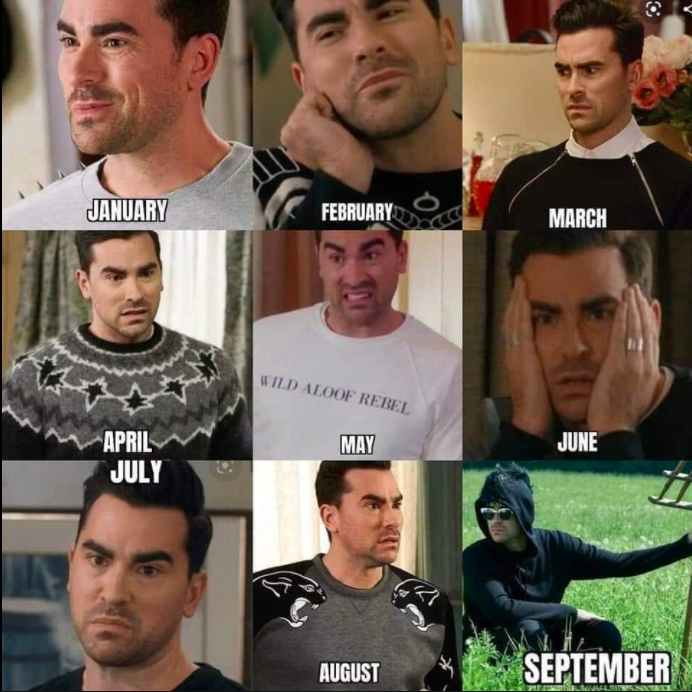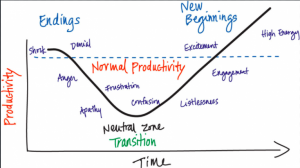
Today’s Buzz is by Stephanie Chase — connect with her on LinkedIn and Twitter
What I’m Reading: Mating in Captivity by Esther Perel
What I’m Watching: waaaay too much Food Network (Guy Fieri goes to some amazing places, y’all)
When I’m Not Reading: experimenting with tiki drinks for my 5pm cocktail
*****
I remember clearly one facilitated work session I was participating in, where our facilitator was helping us match our proposed plan of action, and the plan’s timeline, to the transition curve used by William Bridges in his book Transitions: Making Sense of Life’s Changes. “Some people buy a condo down here at the bottom of the transition curve,” she said; our work needed to be figuring out how to support the majority of staff through the change so they didn’t stay stuck, never transitioning into what the new reality was and then certainly not being part of the new beginnings that were forming.

I love change, and I welcome it, but the past few months have felt like I’m happily decorating my little condo at the bottom of the curve, because it’s what feels safe. How can I break out of this slump and keep moving forward?
Bridges points out that change happens fast — which has certainly been the case with everything I can think of about 2020 — but that the transition through the change is far slower, and much more individual. We grieve what is ending, in which we often spend time shocked, angry, and frustrated; we move into what he calls “the neutral zone,” the bottom of his curve, where we’re frustrated, apathetic, and confused; and then we finally move out of the bottom of the curve into that space of new beginning, where we are energized, and our engagement returns to normal and then, we hope, exceeds where we were before. COVID-19 implemented a rapid, world-shifting change in what feels like a week (bad change management, pandemic!), and all of us are trying to move through the accompanying transition on ground that continues to shift.
What can you do?
-
- If you are still struggling with facing the changes to our world, ask what might help you be resigned to the changes. You don’t have to be happy about them, and, right now, at this point in your journey, you don’t have to be looking for the silver lining in them. But you have to acknowledge them in order to move on.
- If that feels challenging, then you may even need to take a step back and be sure you have properly grieved what you lost. The grief cycle doesn’t care what you’re feeling loss over; it cares that you’re feeling that loss. It is ok to miss the closeness of your work team, the projects you were working on, the staff who have resigned or been let go, the action plan for 2020 you worked so hard on. It’s ok to miss the really good coffee in your staff room (we’re jealous). Read (or read a summary of) Kübler-Ross’ five stages of grief, famously shared in her book On Death and Dying. If you have faced difficult loss in the past, call back to the techniques or supports that helped you at that time.
- Focus on gratitude. UC Davis psychologist Robert Emmons is well-known for his work studying the benefits of practicing thankfulness, and it can be as simple as thinking of one thing that you are grateful for and writing it down. The key is to be specific, so we are constantly giving positive reinforcement to our brains. Instead of “I’m thankful to be working at home,” break it down to why you are thankful to be working at home today, and then keep digging on future days. “I am thankful to have my commute time back” might morph into “I am thankful I can sleep in later” to “I am grateful I can drive so much less and save money/the environment” to “I am thankful for the 15 quiet minutes I can now spend with my coffee instead of rushing out of the house with it” and so forth. It’s like asking the “five whys” for each of your statements!
- It’s easier to be settled in the condo down at the bottom because it’s comfortable there, but remember: change is fast, transition can be slow. You don’t have to think big right now, but you do have to think differently. Like with a gratitude practice, thinking of one thing you can do today to help move your work, your projects, or your organization forward will help re-connect you. Microhabits are important in changing our perspectives and how we invest our time; even the Harvard Business Review has written on them (see January 2020’s “To Achieve Big Goals, Start With Small Habits.”) Since it’s daily, it has to be small; you may have a big goal in mind, but it must be broken down into parts. Perhaps you love how your municipality significantly expanded virtual services, and you want to be sure that level can stay when (if?) we eventually return to a higher level of services in our buildings. Then today, maybe you can start by thinking of what the new services are, and making a list. Tomorrow, a list of what the services looked like before. The next day, adding to the list, if you know, who the expert is on the new, virtual services and the old services. Then brainstorm questions you might be curious about or facts and figures you might need, and then maybe contact two of those people a day, and so forth.
- Lean on your friends and colleagues. Don’t isolate yourself. Reach out to someone you trust, and who understands the setting you are in. The people in our lives who know us can often see what’s ahead for us more clearly than we can; we just need to be brave enough to listen.
